(see figure 1).
| Capability (C011):— representing_analysis_result | Date: 2007/07/11 16:32:00 Revision: 1.10 |
This capability provides the ability to represent an actual analysis result. The result of an analysis generally consists of two sections, firstly a context section describing the context under which the analysis is performed, and secondly a data section which contains the detailed results from the analysis.
NOTE The context information is often represented as general administrative/heading information in a document.
The context section consists of:
NOTE There might be a need for additional heading information. This can be added in capabilities/dex's using this capability.
A detailed description on how to represent the content of a analysis result (the data section) is out of scope of this capability. However, some general usage guidance are given at the end of this capability on how to represent the content and how it could relate it back to the context.
An analysis result is an actual product, produced by someone, and is therefore represented as a
Product_as_realized in the PLCS data model. The actual analysis result
(Product_as_realized) is
a version of a Part.
The Part representing the
type of analysis result should be classified as a subclass of [AnalysisResultDefinitions]![]() Error RDL1: The class AnalysisResultDefinitions does not exist in RDL at URI urn:plcs:rdl:std. Check the dexlib/data/refdata/rdl_index.xml
Error RDL1: The class AnalysisResultDefinitions does not exist in RDL at URI urn:plcs:rdl:std. Check the dexlib/data/refdata/rdl_index.xml
(see figure 1).
EXAMPLE
Examples of subclasses of a the class [AnalysisResultDefinitions]![]() Error RDL1: The class AnalysisResultDefinitions does not exist in RDL at URI urn:plcs:rdl:std. Check the dexlib/data/refdata/rdl_index.xml
Error RDL1: The class AnalysisResultDefinitions does not exist in RDL at URI urn:plcs:rdl:std. Check the dexlib/data/refdata/rdl_index.xml
are [FMECAWorksheet]![]() Error RDL1: The class FMECAWorksheet does not exist in RDL at URI urn:plcs:rdl:std. Check the dexlib/data/refdata/rdl_index.xml
Error RDL1: The class FMECAWorksheet does not exist in RDL at URI urn:plcs:rdl:std. Check the dexlib/data/refdata/rdl_index.xml
and [MaintenancePlan]![]() Error RDL1: The class MaintenancePlan does not exist in RDL at URI urn:plcs:rdl:std. Check the dexlib/data/refdata/rdl_index.xml
Error RDL1: The class MaintenancePlan does not exist in RDL at URI urn:plcs:rdl:std. Check the dexlib/data/refdata/rdl_index.xml
.
The Product_as_realized representing
the actual analysis result should be classified as [Edition]![]() Error RDL1: The class Edition does not exist in RDL at URI urn:plcs:rdl:std. Check the dexlib/data/refdata/rdl_index.xml
Error RDL1: The class Edition does not exist in RDL at URI urn:plcs:rdl:std. Check the dexlib/data/refdata/rdl_index.xml
.
NOTE Details on how to assign reference data is described in the capability C010: assigning_reference_data.
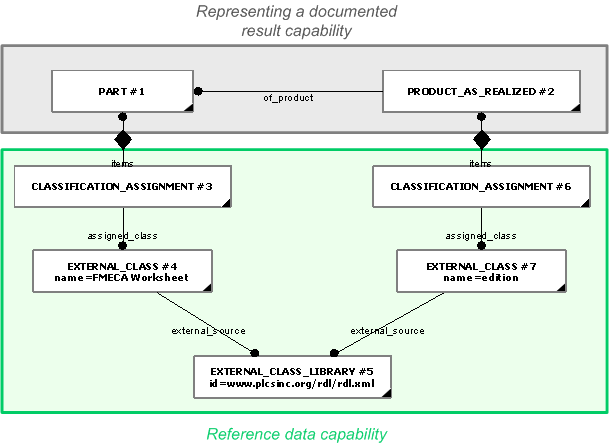
The identification of the analysis result is represented as an
Identification_assignment
being assigned to the Part
using the C001: assigning_identifiers capability. The
Identification_assignment
should be classifed as [AnalysisResultIdentification]![]() Error RDL1: The class AnalysisResultIdentification does not exist in RDL at URI urn:plcs:rdl:std. Check the dexlib/data/refdata/rdl_index.xml
Error RDL1: The class AnalysisResultIdentification does not exist in RDL at URI urn:plcs:rdl:std. Check the dexlib/data/refdata/rdl_index.xml
. (See figure 2 below)
The edition is an identification of the version of the analysis result. This is represented as an
identifier being assigned to the Product_as_realized
using the C001: assigning_identifiers capability . The
Identification_assignment should be classified as
[EditionIdentification]![]() Error RDL1: The class EditionIdentification does not exist in RDL at URI urn:plcs:rdl:std. Check the dexlib/data/refdata/rdl_index.xml
Error RDL1: The class EditionIdentification does not exist in RDL at URI urn:plcs:rdl:std. Check the dexlib/data/refdata/rdl_index.xml
. (See figure 2 below)
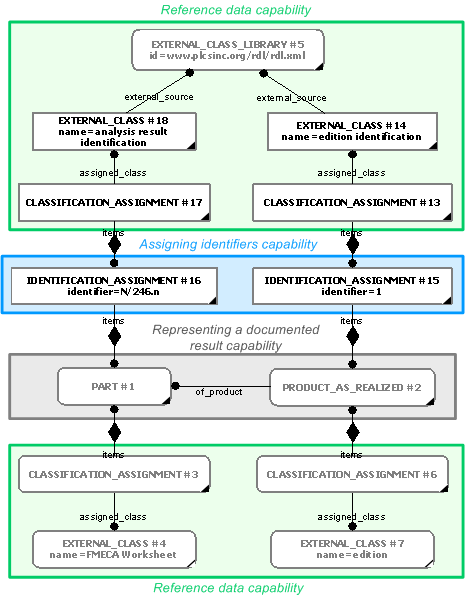
An analysis result is related to either:
A relationship between the analysis result and a Part
(including Part_version)
as the related product, is established using
Product_relationship.
The Product_relationship should be
classified as [ContextItem]![]() Error RDL1: The class ContextItem does not exist in RDL at URI urn:plcs:rdl:std. Check the dexlib/data/refdata/rdl_index.xml
Error RDL1: The class ContextItem does not exist in RDL at URI urn:plcs:rdl:std. Check the dexlib/data/refdata/rdl_index.xml
using the C010: assigning_reference_data capability.
The reference to the identification of the related part is established using the
referencing_part_or_slot![]() Error C1: Capability referencing_part_or_slot not in dex_index.xml
Error C1: Capability referencing_part_or_slot not in dex_index.xml
capability.
A relationship between the analysis result and a
Breakdown_element as the related product,
is established using Product_relationship.
The Product_relationship should be
classified as [ContextItem]![]() Error RDL1: The class ContextItem does not exist in RDL at URI urn:plcs:rdl:std. Check the dexlib/data/refdata/rdl_index.xml
Error RDL1: The class ContextItem does not exist in RDL at URI urn:plcs:rdl:std. Check the dexlib/data/refdata/rdl_index.xml
using the C010: assigning_reference_data capability .
The reference to the identification of the related breakdown element is established using the
referencing_product_breakdown_element![]() Error C1: Capability referencing_product_breakdown_element not in dex_index.xml
Error C1: Capability referencing_product_breakdown_element not in dex_index.xml
capability .
A relationship between the analysis result and a specific
Product_configuration of the related product,
is established via a Product_relationship
to the related Part.
The way the related Part
and its Product_configuration is referenced, is described
in the referencing_part_or_slot![]() Error C1: Capability referencing_part_or_slot not in dex_index.xml
Error C1: Capability referencing_part_or_slot not in dex_index.xml
capability.
The Product_relationship should be
classified as [ContextItem]![]() Error RDL1: The class ContextItem does not exist in RDL at URI urn:plcs:rdl:std. Check the dexlib/data/refdata/rdl_index.xml
Error RDL1: The class ContextItem does not exist in RDL at URI urn:plcs:rdl:std. Check the dexlib/data/refdata/rdl_index.xml
using the C010: assigning_reference_data capability .
The environment for which the analysis is valid is represented as a
State_definition being assigned to the
Part using the
C043: representing_environment_typical capability. The
Applied_state_definition_assignment entity should be
classified as [ValidEnvironment]![]() Error RDL1: The class ValidEnvironment does not exist in RDL at URI urn:plcs:rdl:std. Check the dexlib/data/refdata/rdl_index.xml
Error RDL1: The class ValidEnvironment does not exist in RDL at URI urn:plcs:rdl:std. Check the dexlib/data/refdata/rdl_index.xml
.
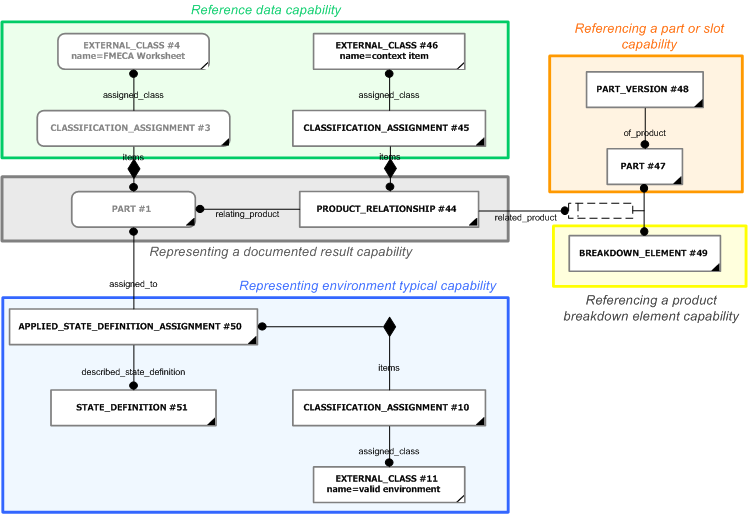
Information regarding a related project is represented as Project
being assigned to the Part
using the capability referencing_project![]() Error C1: Capability referencing_project not in dex_index.xml
Error C1: Capability referencing_project not in dex_index.xml
. The role of the related
Project is represented by classification of the
Project_assignment entity, and should be classified as
[TargetProject]![]() Error RDL1: The class TargetProject does not exist in RDL at URI urn:plcs:rdl:std. Check the dexlib/data/refdata/rdl_index.xml
Error RDL1: The class TargetProject does not exist in RDL at URI urn:plcs:rdl:std. Check the dexlib/data/refdata/rdl_index.xml
.
Dates such as date of issue is represented as
Calendar_date or Date_time
being assigned to the Product_as_realized
(e.g. the date of the edition of the analysis result)
using the C036: assigning_date_time capability. The role of the
date can be represented by classification of the
Date_or_date_time_assignment as described in the
C036: assigning_date_time capability. An example of a class that can be assigned to a
Date_or_date_time_assignment is
[DateOfIssue]![]() Error RDL1: The class DateOfIssue does not exist in RDL at URI urn:plcs:rdl:std. Check the dexlib/data/refdata/rdl_index.xml
Error RDL1: The class DateOfIssue does not exist in RDL at URI urn:plcs:rdl:std. Check the dexlib/data/refdata/rdl_index.xml
. (See figure 3 below)
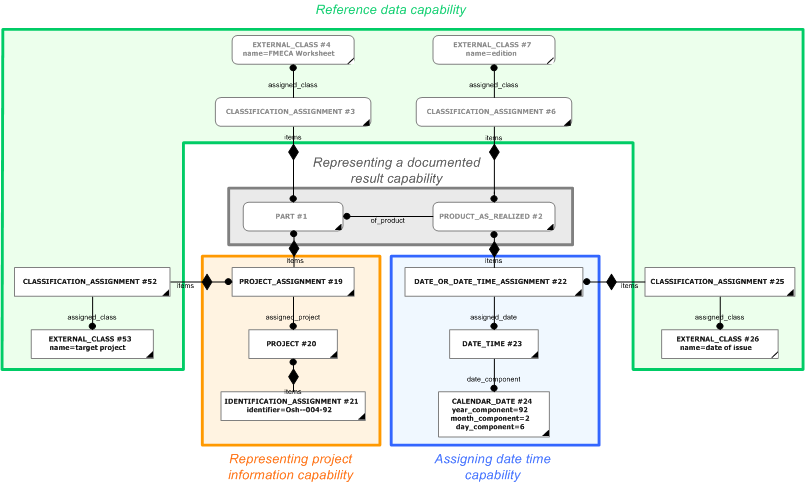
Information about involved parties is represented as a Person,
Person_in_organization or as an
Organization being assigned to the
Product_as_realized (e.g. the edition of the documented result)
using the referencing_person_organization![]() Error C1: Capability referencing_person_organization not in dex_index.xml
Error C1: Capability referencing_person_organization not in dex_index.xml
capability .
The role of the
Person,
Person_in_organization or
Organization can be represented by classification of the
Organization_or_person_in_organization_assignment
as described in the C016: representing_person_organization capability. Typical values
includes [IssuedBy]![]() Error RDL1: The class IssuedBy does not exist in RDL at URI urn:plcs:rdl:std. Check the dexlib/data/refdata/rdl_index.xml
Error RDL1: The class IssuedBy does not exist in RDL at URI urn:plcs:rdl:std. Check the dexlib/data/refdata/rdl_index.xml
and
[Customer]![]() Error RDL1: The class Customer does not exist in RDL at URI urn:plcs:rdl:std. Check the dexlib/data/refdata/rdl_index.xml
Error RDL1: The class Customer does not exist in RDL at URI urn:plcs:rdl:std. Check the dexlib/data/refdata/rdl_index.xml
. (See figure 4 below)
The status of an analysis result is represented as a State being assigned to the Product_as_realized (e.g. the edition of the documented result).
The types of states that a documented result may be in should be defined as classes of
State_definition.
Typical values includes
[Draft]![]() Error RDL1: The class Draft does not exist in RDL at URI urn:plcs:rdl:std. Check the dexlib/data/refdata/rdl_index.xml
Error RDL1: The class Draft does not exist in RDL at URI urn:plcs:rdl:std. Check the dexlib/data/refdata/rdl_index.xml
, [Reviewed]![]() Error RDL1: The class Reviewed does not exist in RDL at URI urn:plcs:rdl:std. Check the dexlib/data/refdata/rdl_index.xml
Error RDL1: The class Reviewed does not exist in RDL at URI urn:plcs:rdl:std. Check the dexlib/data/refdata/rdl_index.xml
and
[Final]![]() Error RDL1: The class Final does not exist in RDL at URI urn:plcs:rdl:std. Check the dexlib/data/refdata/rdl_index.xml
Error RDL1: The class Final does not exist in RDL at URI urn:plcs:rdl:std. Check the dexlib/data/refdata/rdl_index.xml
.
The Applied_state_assignment should be
classified as [InState]![]() Error RDL1: The class InState does not exist in RDL at URI urn:plcs:rdl:std. Check the dexlib/data/refdata/rdl_index.xml
Error RDL1: The class InState does not exist in RDL at URI urn:plcs:rdl:std. Check the dexlib/data/refdata/rdl_index.xml
.
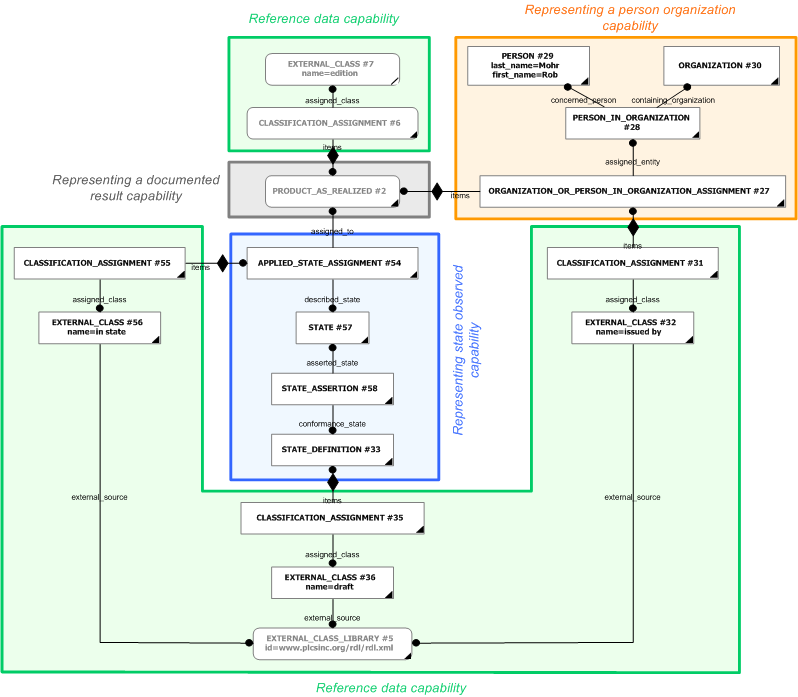
The approval of a documented result is represented as a Approval being assigned to the Product_as_realized (e.g. the edition of the documented result) using the capability C019: assigning_approvals.
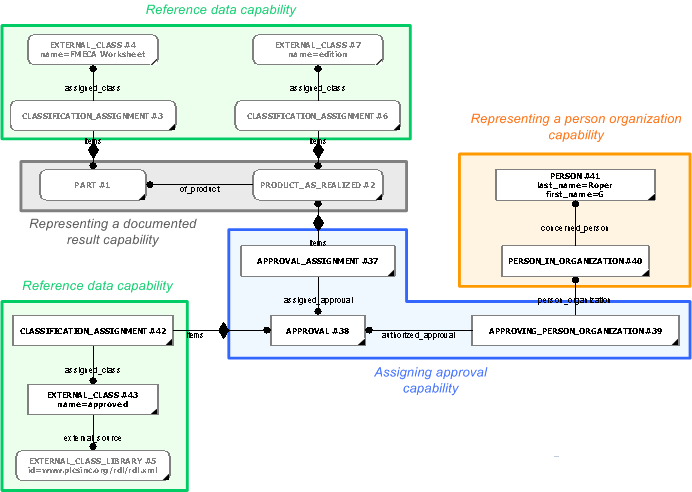
References to documents related to an analysis result are represented as
Document_assignment being assigned to the
Product_as_realized
(e.g. the edition of the documented result) using the referencing_documents![]() Error C1: Capability referencing_documents not in dex_index.xml
Error C1: Capability referencing_documents not in dex_index.xml
capability.
The Document_assignment should be
classified as [Reference]![]() Error RDL1: The class Reference does not exist in RDL at URI urn:plcs:rdl:std. Check the dexlib/data/refdata/rdl_index.xml
Error RDL1: The class Reference does not exist in RDL at URI urn:plcs:rdl:std. Check the dexlib/data/refdata/rdl_index.xml
The content information (data section/details) reflects e.g. records or rows in a report.
The content in the data section vary with the type of analysis result being exchanged. This means that this capability can not provide any detailed guideance on how to represent the details of the content information since the representation will be context dependent.
However, a generic usage guideance is that the respective record/row has a root entity which will be assigned to both the Product_as_realized representing the edition of the analysis result, as well as to a Breakdown_element or an assembly (Part) of the product that's regarded as the "related product".
An example of a representation of content information is a record within an FMECA worksheet. The records within the FMECA worksheet is based on possible functional failures that might occur on a system/function within the "related product". The root entity for this record is the entity representing the functional failure, e.g. a State_definition classified as "functional failure" (see the C007: representing_state_type capability). This root entity has to be associated with both the Product_as_realized representing the edition of the analysis result, and the Functional_element that is representing a function within the "related product". This accomplished using two separate instances of Applied_state_definition_assignment:
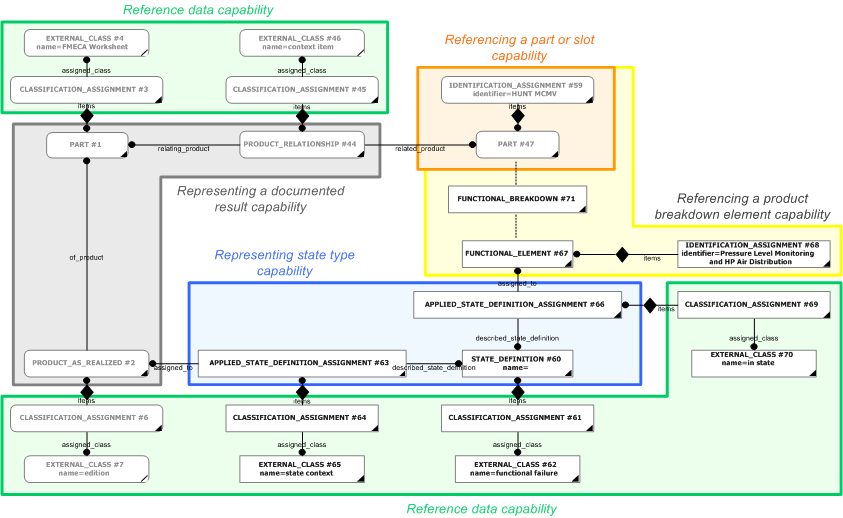
This capability "Representing the context of an analysis report" is related to the following capabilities:
This capability "Representing the context of an analysis report" is dependent on the following capabilities:
The following classes of reference data are required for this capability:
[MaintenancePlan]© OASIS 2010 — All rights reserved